

Several segments from films shot in London in the late ’60s, apparently for television, are included. Kodar also screens Welles’ very funny and idiosyncratic trailer for “F for Fake,” which was rejected as too long by the film’s distrib and remained unseen until now. Revelatory footage comes from material shot for the uncompleted “Moby Dick.” There are also scenes, apparently promo reels, from a projected film of Isak Dinesen’s novel “The Dreamers,” filmed in 1980 at Welles’ Hollywood house, with Kodar as an opera diva who has lost her voice and Welles as her elderly protector.
#ORSON WELLES ONE MAN BAND TV#
Same story was filmed more recently by Phillip Noyce as “Dead Calm.”Ī sequence from “The Merchant of Venice” suggests that this TV film, if completed, would have offered a definitive Shylock from Welles his moving rendition of the famous “If you prick us, do we not bleed?” speech is interrupted when the film simply runs out.

Even in these brief fragments, an eerie atmosphere pervades, quite at odds with the sun-drenched seascapes and luxury yachts. Several glimpses of “The Deep,” which was filmed off the Dalmatian Coast between 19, depict an avuncular Welles with Jeanne Moreau and Kodar, and a bearded Laurence Harvey as the psychopathic villain. The erotic goings-on in the car represent a first for Welles, too, in their depiction of sexuality it’s a remarkable sequence. The freewheeling style of this sequence is quite unlike anything Welles had done before, and seems influenced by the post-“Easy Rider” style of low-budget American filmmaking.Īnother sequence from “Wind” shows Kodar driving through a rainswept night in the company of two young men. The preliminaries over with, we enter previously uncharted territory with a sequence from “The Other Side of the Wind,” which was filmed on and off between 19 in the sequence shown, John Huston plays a veteran film director who, accompanied by Peter Bogdanovich, fields questions from members of the press, including Susan Strasberg. There’s a brief intro, composed of stills from Welles’ famous films, which establishes the director’s credentials, followed by the witty acceptance speech he made when he received the American Film Institute lifetime achievement award in 1975. Kodar talks about Welles as she drives to and from the warehouse where reels of his unseen films are stored, some of them, apparently, still under legal constraints.

The German film team managed to get the cooperation of Welles’ longtime companion, Oja Kodar, who gets the unusual opening credit “A Film Made Possible by Oja Kodar” in the final credit crawl she receives co-director billing with Vassili Silovic, who is given the solo credit at the front.


 0 kommentar(er)
0 kommentar(er)
